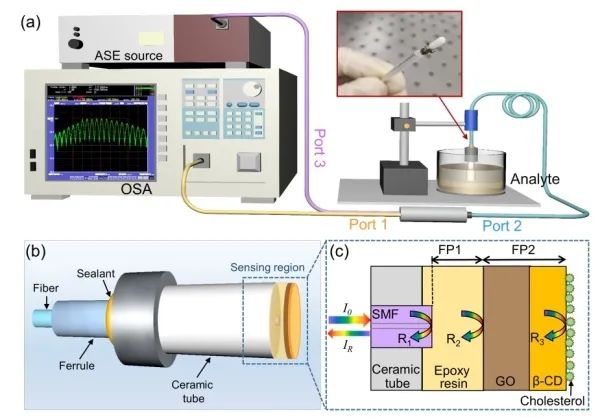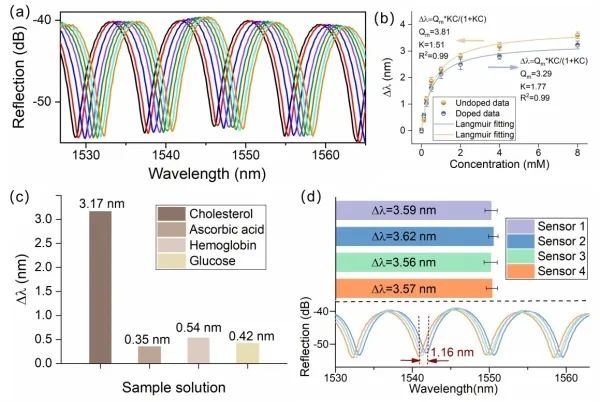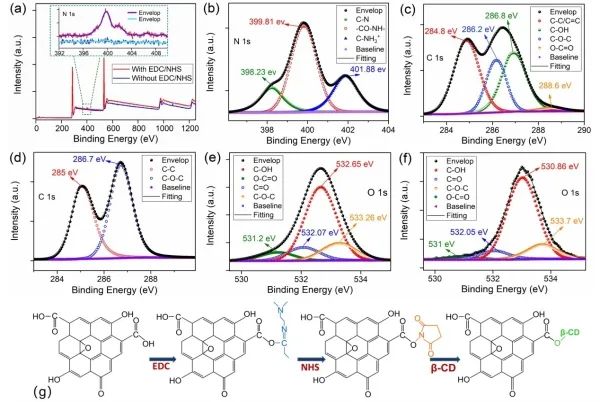Recently, the Xi’an Institute of Optics and Precision Mechanics of the Chinese Academy of Sciences collaborated with Northwest University to achieve significant progress in the research of surface-functionalized optical fiber sensors. The research developed a label-free, high-sensitivity, and high-selectivity Fabry-Perot type interference probe based on communication single-mode optical fibers. This probe features convenient testing, low cost, and high temperature stability, showing broad application prospects in the spectral detection of biomacromolecules.
Cholesterol is an important lipid macromolecule found in cell membranes, lipoproteins, nerve cells, and brain cells, and its concentration is closely related to diseases such as heart disease, hypertension, atherosclerosis, and stroke. Therefore, cholesterol level detection has garnered significant attention. Compared to commonly used detection methods such as electrochemical methods, enzyme analysis, liquid chromatography, and mass spectrometry, optical fiber spectral detection methods stand out due to their small size, resistance to electromagnetic interference, extremely low cost, and label-free characteristics, making them highly regarded in the field of biochemical detection.
Traditional optical fiber spectral detection devices (such as long-period gratings, tilted gratings, and surface-etched Bragg gratings) face significant limitations in practicality due to strict requirements for preparation instruments and cross-sensitivity to temperature and deformation. The team approached the problem from the perspective of optical interference theory and the interaction between light and matter, using single-mode fibers and fiber inserts to fabricate optical fiber spectral detection devices. They sequentially coated a multilayer functional film of epoxy resin-graphene oxide (GO)-β-cyclodextrin on the end face of the fiber insert using van der Waals forces. This design leverages the hydrophobic hollow molecular structure of the outermost β-cyclodextrin layer and its targeted adsorption principle with cholesterol molecules to achieve high-sensitivity spectral concentration detection of cholesterol molecules. It also demonstrates strong selectivity against common interfering substances in biochemical analysis, such as urea, glucose, ascorbic acid, and human hemoglobin, with a detection limit of 3.5M and a sensitivity of 3.92 nm/mM. This achievement provides new ideas and methods for the application of surface-functionalized optical fiber devices in biochemical spectral analysis.
Additionally, the research utilized X-ray photoelectron spectroscopy (XPS) to investigate the impact of EDC/NHS-activated GO carboxyl groups on intermolecular bonding interactions and the bonding characteristics between β-cyclodextrin and cholesterol molecules, validating the detection mechanism.
The related research results were published in Analytica Chimica ACTA. The Xi’an Institute of Optics and Precision Mechanics is the first completion unit and the corresponding unit.

Figure 1. (a) Experimental setup; (b)(c) Interference structure.

Figure 2. (a) Cholesterol detection spectrum; (b) Langmuir fitting of detection wavelengths for doped/undoped samples; (c) Selectivity; (d) Device preparation reproducibility testing.

Figure 3. XPS results. (a) XPS spectra of EDC/NHS unactivated/activated carboxyl sensors; (b) N 1s spectrum of activated carboxyl sensors; (c)(d) C1s spectra of carboxyl sensors with/without EDC/NHS activation; (e)(f) O1s spectra of EDC/NHS treated sensors; (g) Schematic of EDC/NHS active carboxyl groups.
Source: Xi’an Institute of Optics and Precision Mechanics, Chinese Academy of Sciences

This account’s articles are defaulted to enable WeChat “Quick Reprint”.
Please indicate the source when reprinting.
For other channels, please contact us.